Key takeaways:
- Ancient grains like quinoa and farro are nutrient-dense, offering essential proteins, fiber, and micronutrients that benefit health and wellness.
- These grains contribute to sustainability, as many are drought-resistant and require fewer resources compared to conventional crops.
- Cooking techniques such as rinsing, toasting, and pressure cooking can enhance the flavor and nutrition of ancient grains.
- Incorporating ancient grains into meals can elevate dining experiences, creating memorable moments around the table.
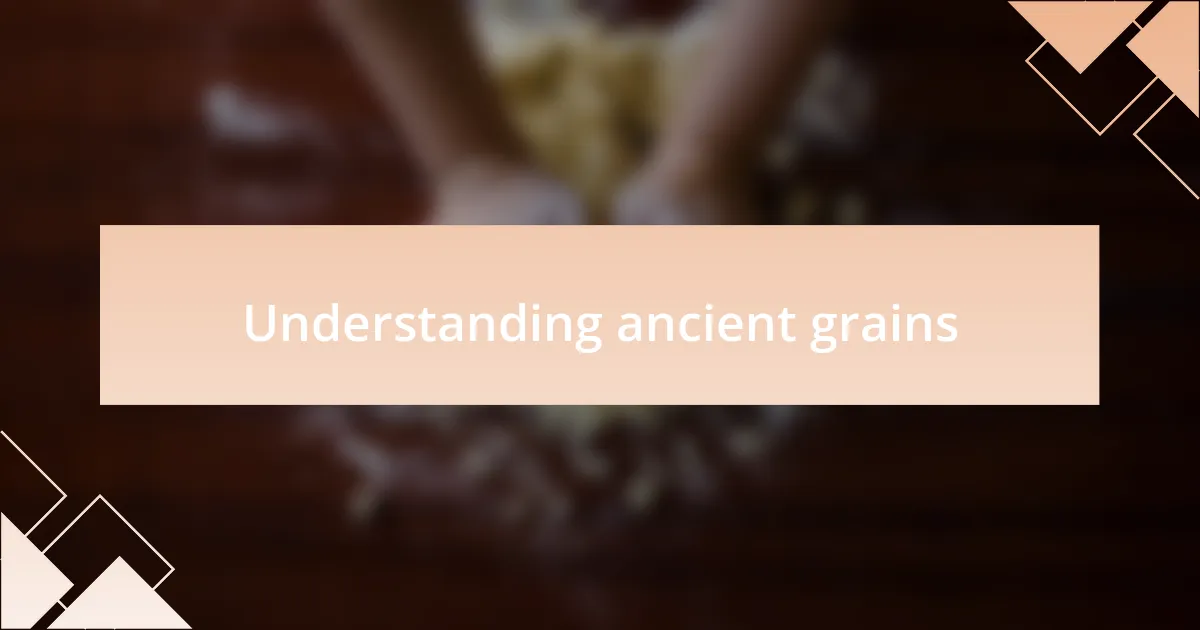
Understanding ancient grains
When I first stumbled upon ancient grains, I was captivated by their rich history and nutritional benefits. These grains, like quinoa and farro, have been cultivated for thousands of years, often providing essential nutrients to various cultures. Isn’t it fascinating to think about how these grains have survived through generations, becoming staples in our modern diets?
My discovery of ancient grains was accompanied by a sense of nostalgia, as I reflected on family meals that featured whole grains. I remember my grandmother using barley in her soups, creating a comforting dish that tied me to her roots. Could there be a more profound connection between our culinary past and present than the grains we choose to embrace?
Delving deeper into the world of ancient grains, I’ve come to appreciate their diversity. Each grain carries its own unique flavor and texture, opening up a world of culinary possibilities. How often do we overlook these treasures in favor of more processed alternatives? Exploring ancient grains can truly transform our approach to cooking and eating.
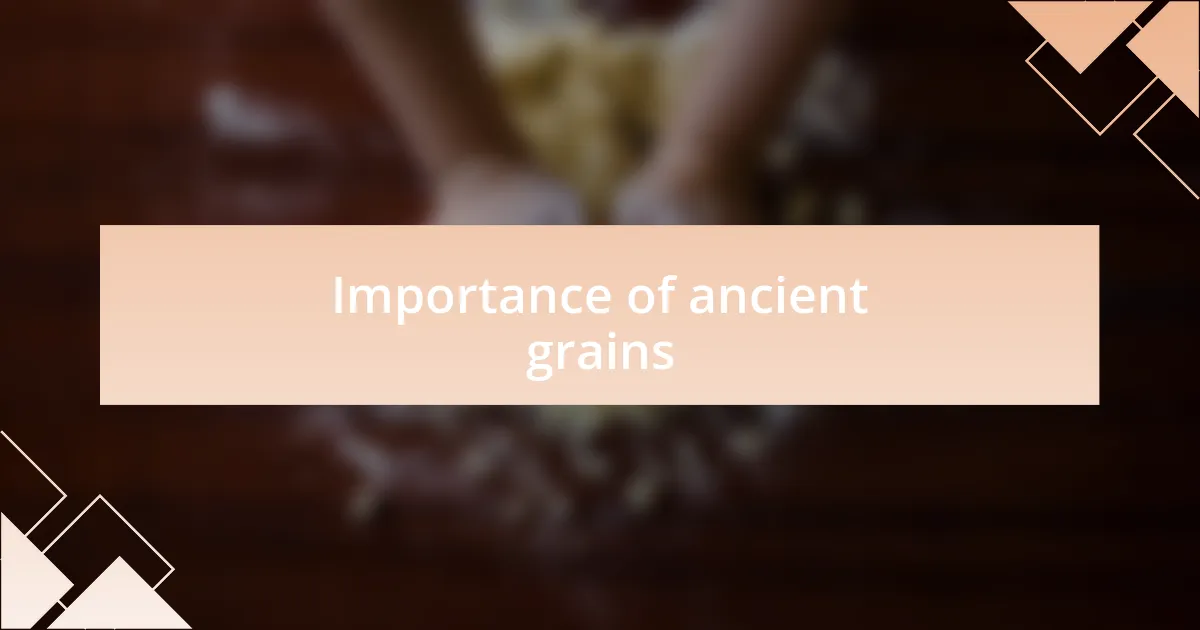
Importance of ancient grains
When I first learned about the nutritional significance of ancient grains, I was amazed by their nutrient density. For instance, grains like millet and amaranth are packed with protein, fiber, and micronutrients that we often lack in our modern diet. It made me realize that incorporating these grains can have a profound impact on our overall health, turning simple meals into nutrient-rich feasts.
I recall a time when I decided to swap out regular rice for farro in a risotto I was making for friends. The texture and nuttiness it added were unexpectedly delightful, sparking conversations around the table about how we could revitalize our meals with these forgotten grains. It’s incredible how ancient grains not only nourish our bodies but can also create memorable experiences and connections through food.
Moreover, there’s an environmental importance to these grains that resonates with me. Many ancient grains are drought-resistant and require less input than conventional crops, making them sustainable choices in a world facing climate challenges. Doesn’t it feel rewarding to choose foods that nourish both our bodies and the planet?
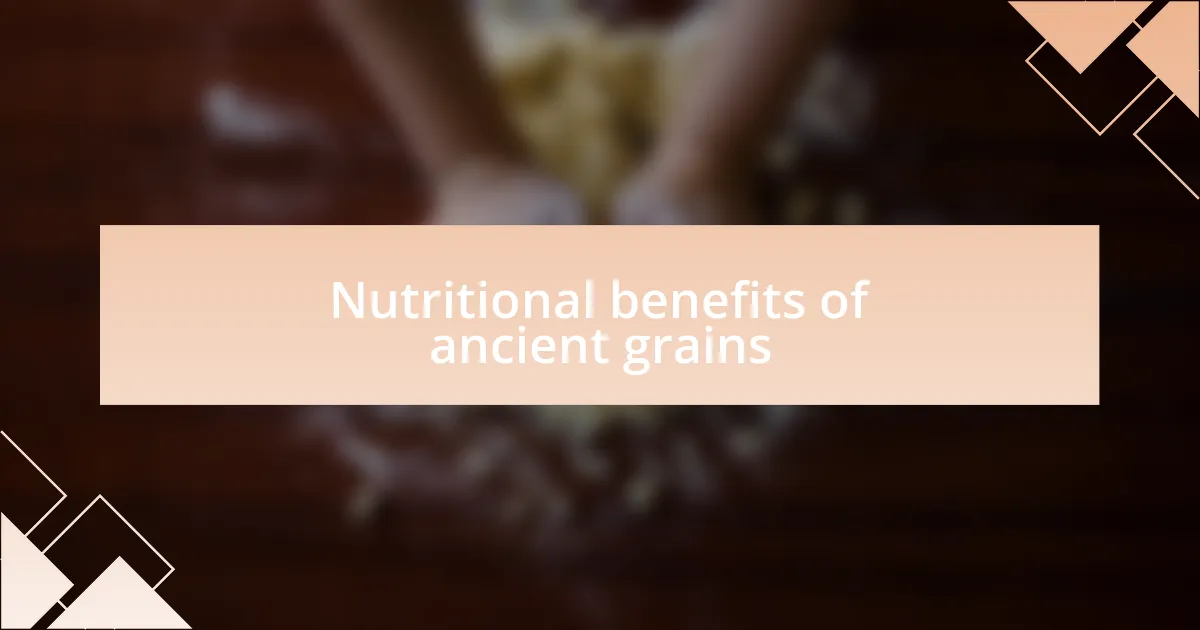
Nutritional benefits of ancient grains
Ancient grains are a powerhouse of nutrition, often containing more protein and fiber than modern grains. For example, I was surprised to learn that quinoa boasts all nine essential amino acids – a rarity in plant foods. When I first introduced it into my breakfast routine, I felt more energized and satisfied throughout the morning compared to my usual oatmeal.
What struck me the most was the role of these grains in stabilizing blood sugar levels. I have a friend who has struggled with blood sugar spikes, and after incorporating farro and spelt into her meals, she noticed significant improvements in her energy levels. It made me wonder: how many people are unaware that simple dietary changes can lead to such powerful benefits?
Incorporating ancient grains also means accessing a variety of vitamins and minerals often missing from our diets today. I remember experimenting with teff, which is rich in calcium and iron, while making a hearty stew. The addition of these grains not only enhanced the dish’s flavor but also contributed to my overall well-being – it was a delicious reminder that healthy eating doesn’t have to be bland or boring.
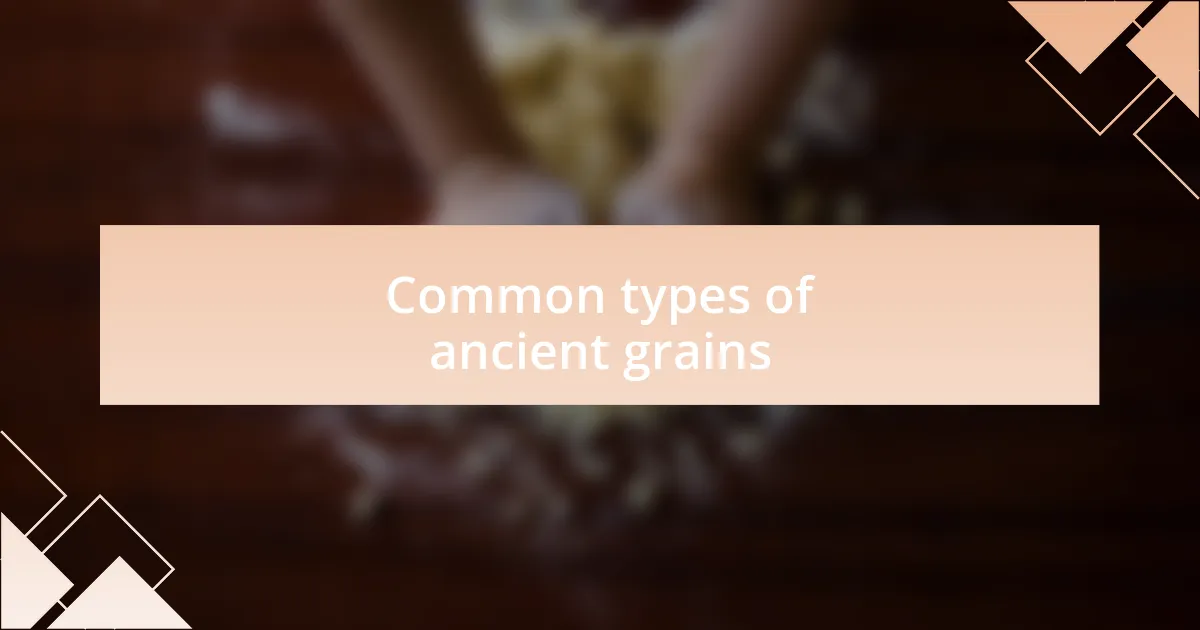
Common types of ancient grains
When it comes to ancient grains, quinoa often takes center stage for good reason. I remember the first time I cooked it; the fluffy texture and slightly nutty flavor surprised me. It’s not just a pretty face, though—its status as a complete protein makes it a go-to for anyone looking to boost their nutritional intake. Have you ever felt unsure about plant-based proteins? Quinoa could be the answer you’ve been searching for.
Then there’s farro, a grain with a bit more chew to it, which I often use in salads. The first time I tossed farro with roasted vegetables, I couldn’t believe how much it elevated my meal. Its hearty texture and earthy taste provide a comforting foundation that pairs beautifully with just about anything. Have you tried farro? I can’t recommend it enough for a simple yet satisfying dinner.
Another ancient grain worth mentioning is millet, which I discovered during a health workshop. The population of attendees was skeptical, but after trying a millet porridge topped with fruits and nuts, I saw eyes widen with delight. It’s incredible how something so small can offer vast nutritional benefits—it’s a reminder that often, the best things come in unassuming packages. Have you explored any new grains lately? You might find a favorite in the most unlikely of places.
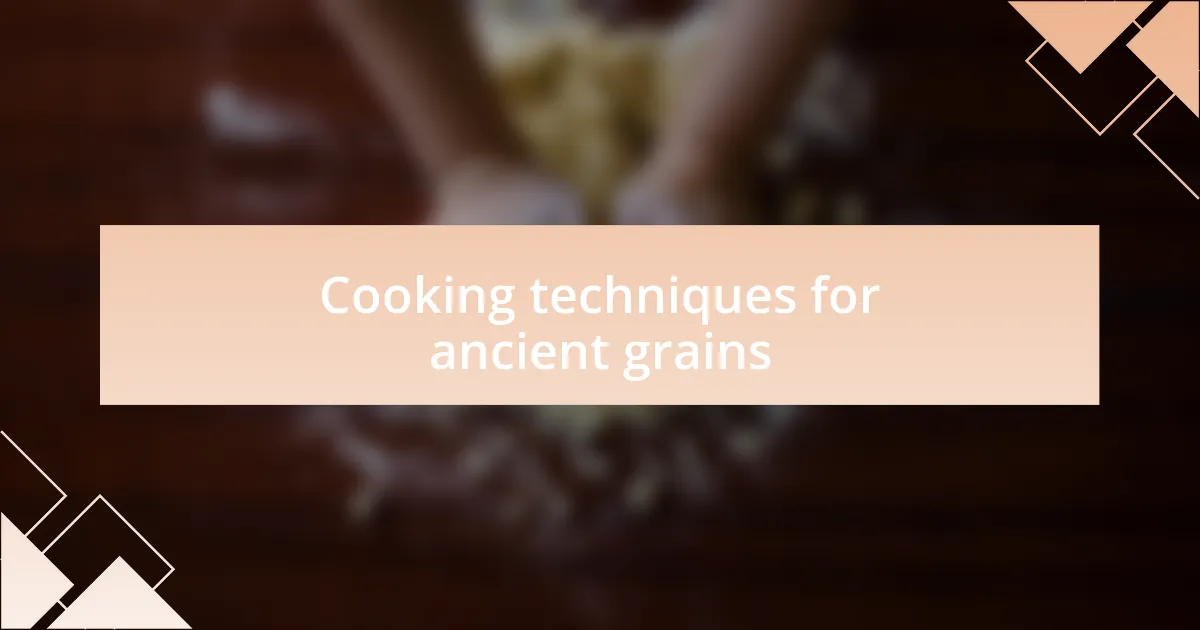
Cooking techniques for ancient grains
When it comes to cooking ancient grains, rinsing them well is often a crucial first step. I remember the first time I made amaranth; I was amazed to see the water turn cloudy. It taught me that this simple act helps remove any bitter residue, allowing the natural flavors to shine. Have you ever ignored the rinse? You might be surprised by how much better your grains can taste.
For cooking techniques, I’ve found that toasting grains before boiling can elevate their flavor profile significantly. During one of my weekend cooking sessions, I decided to toast some quinoa in a dry pan. The aroma filled my kitchen, and the nutty notes enhanced the final dish in a way I never expected. Have you tried this technique yet? It’s a game-changer for those seeking depth in their meals.
Pressure cooking is another technique I’ve really embraced with ancient grains, especially when I’m pressed for time. There was a day when I needed a nutritious side dish in a flash, so I tossed some barley into my electric pressure cooker along with water and herbs. In under 20 minutes, I had perfectly cooked barley that was ready to pair with roasted vegetables. Isn’t it incredible how technology can help us enjoy wholesome meals without the waiting?
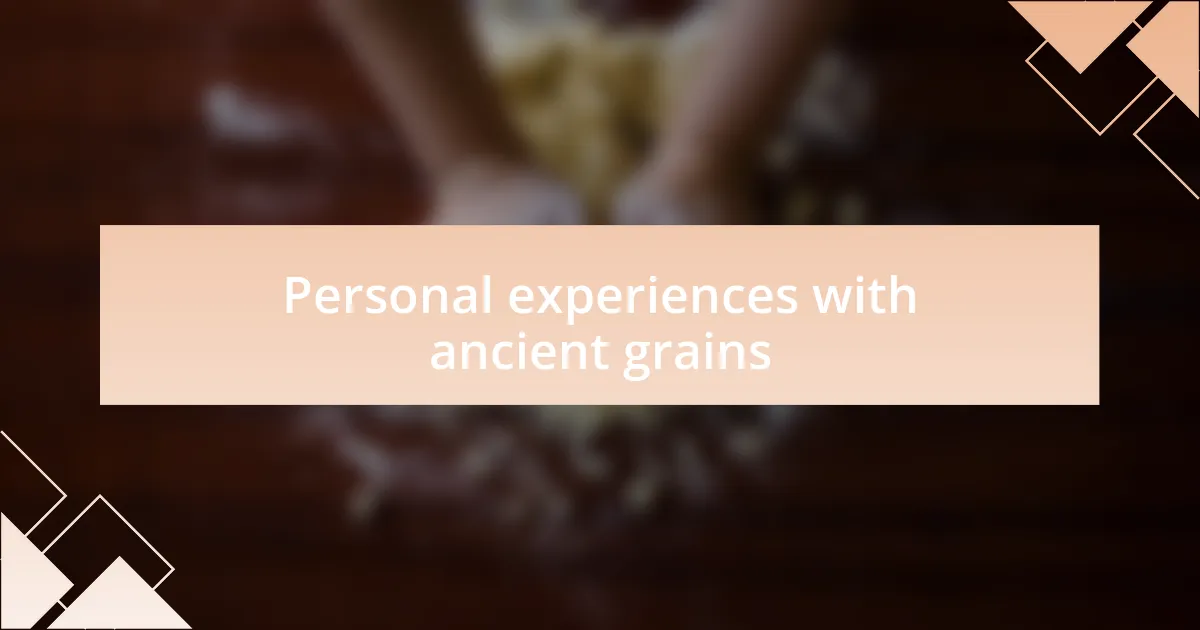
Personal experiences with ancient grains
My journey with ancient grains started unexpectedly during a wellness retreat. I was introduced to spelt and offered a hearty bowl of spelt salad. The grain had a lovely chewy texture, and I was struck by how satisfying it felt. Have you ever felt a simple meal elevate your mood? That initial experience ignited my curiosity to explore more about ancient grains and their health benefits.
Another memorable encounter was when I experimented with farro while preparing a family dinner. I decided to substitute my usual rice with farro, thinking it might intrigue my guests. As I watched their faces light up with every bite, I realized that these grains not only provide nutrition but can also transform a typical dinner into a memorable experience. There’s something magical about introducing others to new tastes, don’t you think?
More recently, I took on the challenge of making my own ancient grain bread. The process was lengthy but ultimately fulfilling. Kneading the dough felt therapeutic, and the smell of freshly baked einkorn bread wafting through my home was nothing short of divine. Have you ever baked something that made your house feel like a warm hug? It was in those moments that I truly grasped the depth of connection one can have with food, especially when working with such time-honored ingredients.
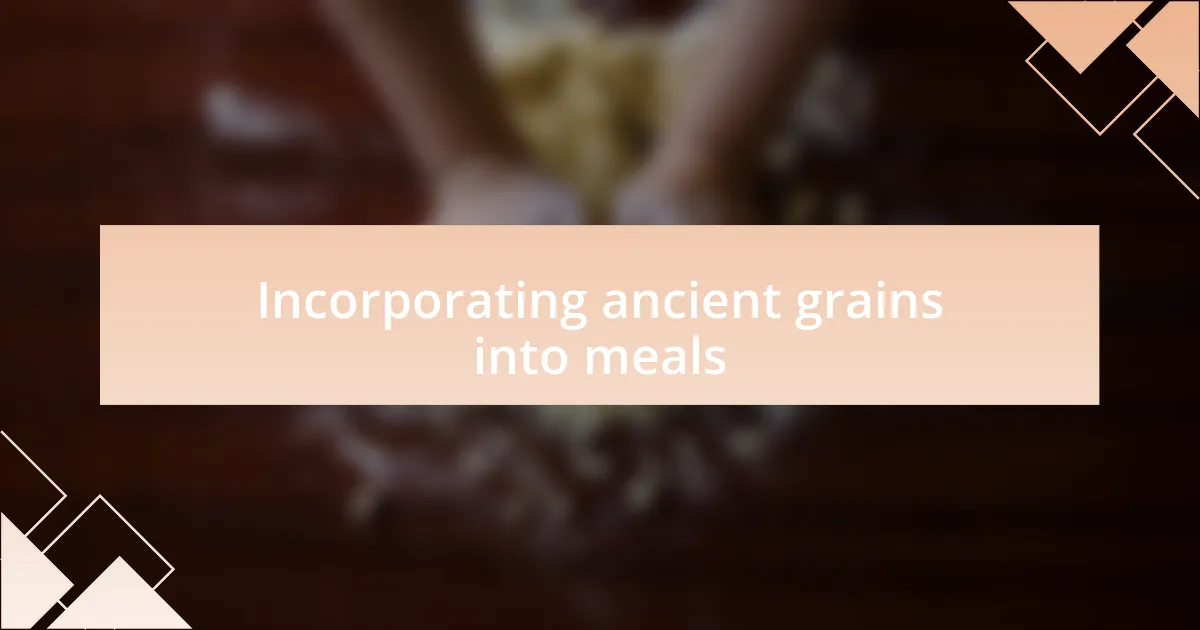
Incorporating ancient grains into meals
Incorporating ancient grains into meals is an exciting adventure, and I love to think of it as exploring a world of flavors and textures. For example, I often add quinoa to my morning breakfast bowl alongside yogurt and fresh fruit. The slight nuttiness of the quinoa adds a delightful crunch that perfectly complements the creaminess of the yogurt. Have you tried elevating your breakfast with this wholesome grain?
When it comes to salads, I find that mixing different ancient grains can create a vibrant and satisfying dish. A recent favorite of mine is a blend of millet and amaranth tossed with roasted vegetables and a zesty lemon dressing. The unique flavors meld beautifully, leaving everyone asking for the recipe. Have you ever had a salad that not only filled you up but also made you feel good about your meal choices?
For dinner, I’ve taken a liking to using barley in my soups. It gives a hearty body to broths and is a wonderful way to add a nutritious element to classic recipes. I recall a chilly evening spent with friends, where I served a barley and vegetable soup that sparked lively conversations and laughter around the table. There’s something about sharing a warm meal that fosters connection, don’t you think?